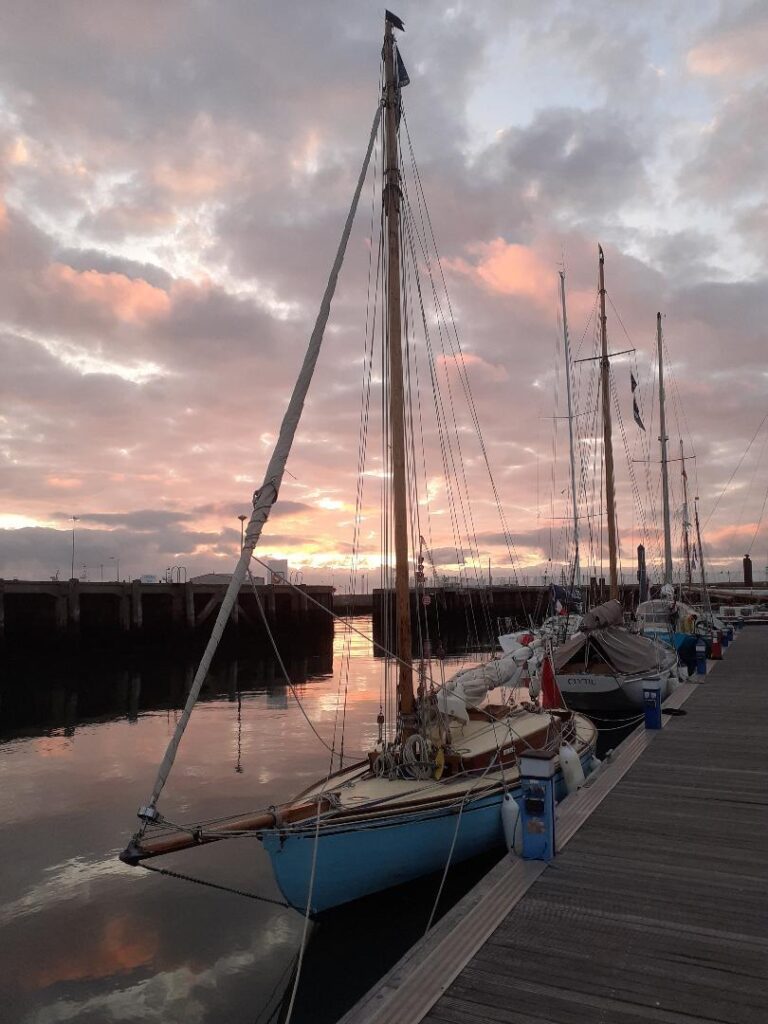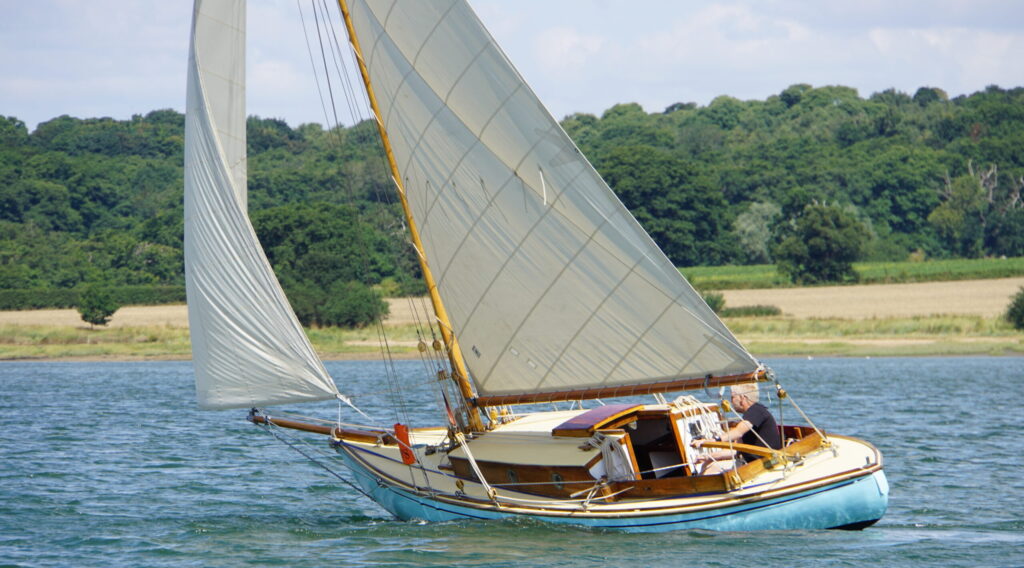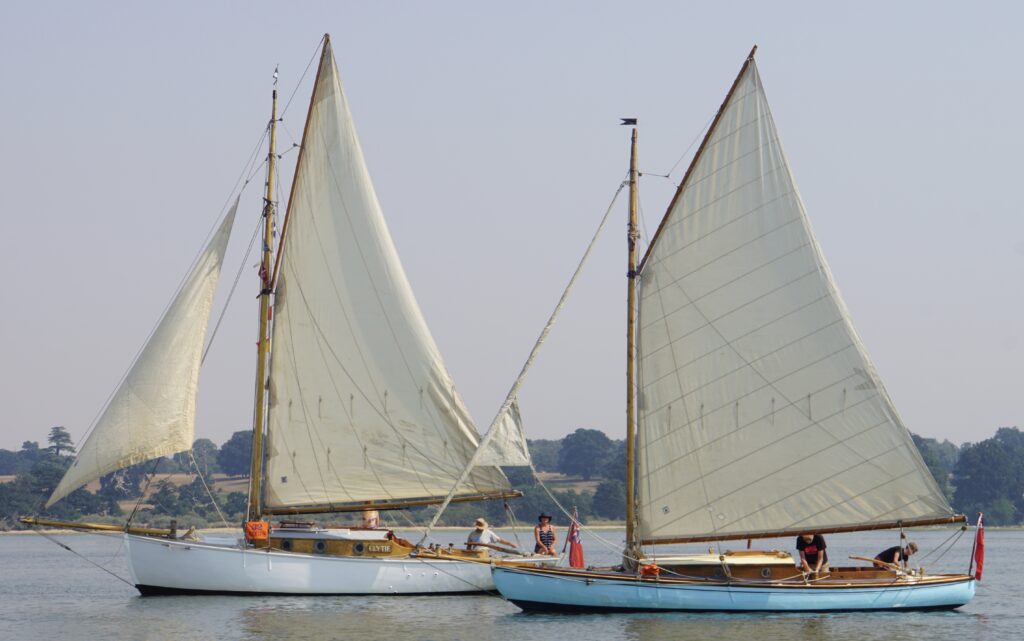Rik Graham provides the ‘short long history’ of ‘Kelpie II’, built in 1902 and celebrating her 120th anniversary last year. No owner has yet sold ‘Kelpie’ in order to move on to another boat; I do not think I will. I would have to find a boat that suits me better first. Four owners, two moorings, 120 years, a short history for such a long time.
Imagine you are a young man of somewhat limited means, keen on sailing, and you and your brother want your own boat. Buying a new boat is beyond the means of a working man, even a manager in his father’s building business, but if you could build one for yourselves you could manage the material costs. Building boats is not easy in your time, there are no kit boats, no ‘build it at home’ plans from understanding designers, no reliable marine glues or fillers, ply wood and laminating are far in the future; it is either traditional plank on frame construction or nothing. In 1900 there is very little for the ‘home’ boatbuilder because there are so very few of you. There are boatyards down on the Thames that may offer advice and you have skill as a joiner, but the challenges are great.
A sensible man would gravitate to a simple tried and tested form with easy building techniques, something traditional and known. But a sensible man would have dismissed the idea as too much to take on from the start. Defying logic, Herbert Kennard (with the assistance of his brother Albert), decided to build a radical plate and bulb keel, light weight, ‘canoe yacht’, designed by a London lawyer called J Pain Clark. Pain Clark was a keen sailor and canoeist who thought that canoe design could beneficially influence yacht design. He had a budding reputation for designing speedy boats, and Herbert was a racing man. The boat design was originally drawn for a yacht called ‘Rani IV’ built in1901 by the Burnham Yacht Company for a Mr C B Matthews of London.
26ft long, 6ft 6in beam and drawing 3ft 9in, it goes without saying that she was gaff rigged. The design displacement was 4,000lbs of which 2,000lbs was lead for the bulb. Coincidently, or maybe not, another extant example of Pain Clark’s work, ‘White Moth’, was amateur built by Col. Wyckham Martin of furling gear fame.
Even given that they were building the boat themselves this was to be an expensive project. The boat ready for sea cost £82 5s 5d, (£82.27p) when a skilled man earnt 8d (4p) per hour. That is 61 weeks of work, or about £32,000 in today’s money. Having nowhere suitable available they also had to erect a shed in which to build her, which they did in their father’s works yard in Lewisham. After a journey down to the river on a wood cart she was launched at Greenwich, probably in Deptford creek, with the river police in attendance. She first took to the water at 14.00 on Saturday 28 June 1902 and was christened ‘Kelpie II’.
She was then towed to Erith about 15 miles downstream and they picked up a mooring at Erith Yacht Club. They completed fitting out, finishing the details of the rig and provisioning, and next Saturday set off down the Thames and up the East Coast for a holiday cruise. Four people lived on board for nine days hopping up the coast and getting as far as Pin Mill, a hamlet on the Orwell in Suffolk. Conditions on board must have been a far cry from those expected today. The cabin would just fit three men sleeping abreast with ‘the ships boy’ in a pipe cot in the very narrow forepeak. It is evident that they were very happy with the boat and her sailing qualities, delighting in her speed and weatherliness. She seems to have cruised the coast most summers, apart, of course, from the war years, but Herbert also raced her frequently at club level, at Erith Yacht Club where she had a permanent mooring.




Herbert was a very early member of the club which was founded in 1900. He is reputed to have still been racing there, and winning, in his 80th year. Even in the post war years Herbert sailed in ‘proper’ rig, duck trousers, pea jacket or blazer, white shirt with club tie and cap. But all things come to an end. As time passed Herbert sailed less and by the late 1940’s David his son was sailing the boat more than his father. Eventually Herbert passed on his boat to David who carried on the tradition of cruising the Essex rivers and Thames estuary, particularly liking the Ore and Alde. He became commodore of Erith in 1970, a position he held until 1974. David retired from his job as a registrar for London University and bought a house in Pin Mill in 1973. The next year he and his friend Barry Page sailed ‘Kelpie’ to Pin Mill to take up her second permanent mooring. Dave settled himself into the community, where he was already a familiar face, becoming well known and liked. He based the boat there racing, cruising and day sailing. ‘Kelpie’ is still known by the older inhabitants of this little hamlet as Dave Kennard’s old boat.
Dave’s sailing partner Barry Page was offered a job by an electronics firm in Colchester and moved there from Rochester in 1981 but is still remembered by older members of Erith Yacht Club with affection. He bought ‘Kelpie’ from Dave in April 1988 and took her mooring over. He paid £500 for the boat but, as Dave explained in a letter between them, knowing where she was going was more important to him than the money. For most of her life ‘Kelpie’ had overwintered either afloat or in saltings but for the past few years had been coming ashore out of season to King’s Boatyard. Barry looked after the boat as best he could and had some crucial work done. Her keel plate was doubled at some point and Barry had her decks sheathed in ply and epoxy. One of her garboards was replaced in 1992 and a new mast was built in 1990, but apart from general maintenance and re-fastening those were the only major projects. Although I think it is in some ways regrettable that the decks are sheathed, I would not have bought her if she had needed re-decking.
I used to have a mooring next to ‘Kelpie’ when I kept my previous boat, a Victorian racer, at Pin Mill. I used to row past and think that if I changed to a boat with a lid she would be my ideal. I approached Barry in the yard one day and asked that if he ever thought of selling ‘Kelpie’ he would talk to me first. He told me that he thought she was getting a bit much to cope with but he would have to check with his family before making a decision. I have since learned that by this time Barry was suffering from the early stages of an undiagnosed illness. I got the impression that he checked my suitability as the next owner of a boat that he loved. I obviously passed muster and a sale was duly arranged. I sold my Orford Whitewing, ‘Quinque’ and took over ‘Kelpie’ in 2004.

It was evident that Kelpie, although she was still sailing, had been taken somewhat for granted. I do not think I am being unfair to her previous owners saying that. I know it takes either a lot of money, or skill and time to keep a centenarian going, and given Barry’s condition it is not surprising that things had slipped a bit. The problem with the keel would be particularly challenging to anyone but a skilled welder. I have spent the intervening years slowly working through the jobs that needed doing and am now happy that she is strong, sound and good for the future. I would like to add a note of thanks to Gus and Sarah at Kings Boatyard, Pin Mill for their forbearance, assistance and advice during the time I have owned ‘Kelpie’.
Words: Rik Graham

You must be logged in to post a comment.